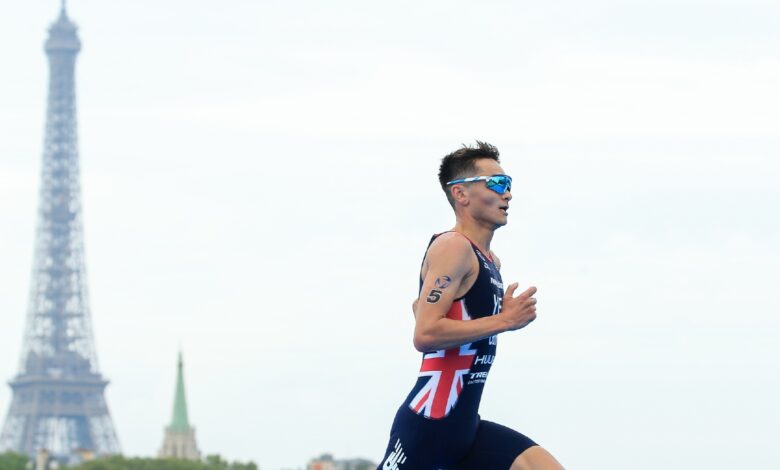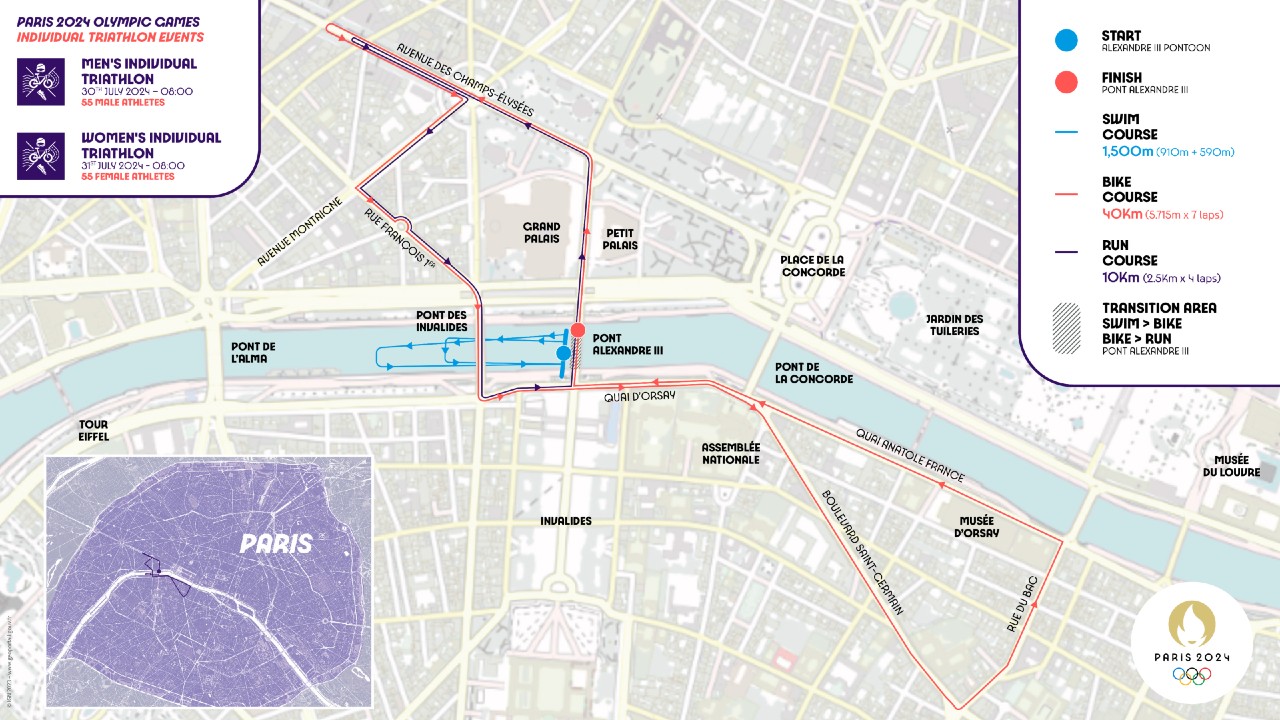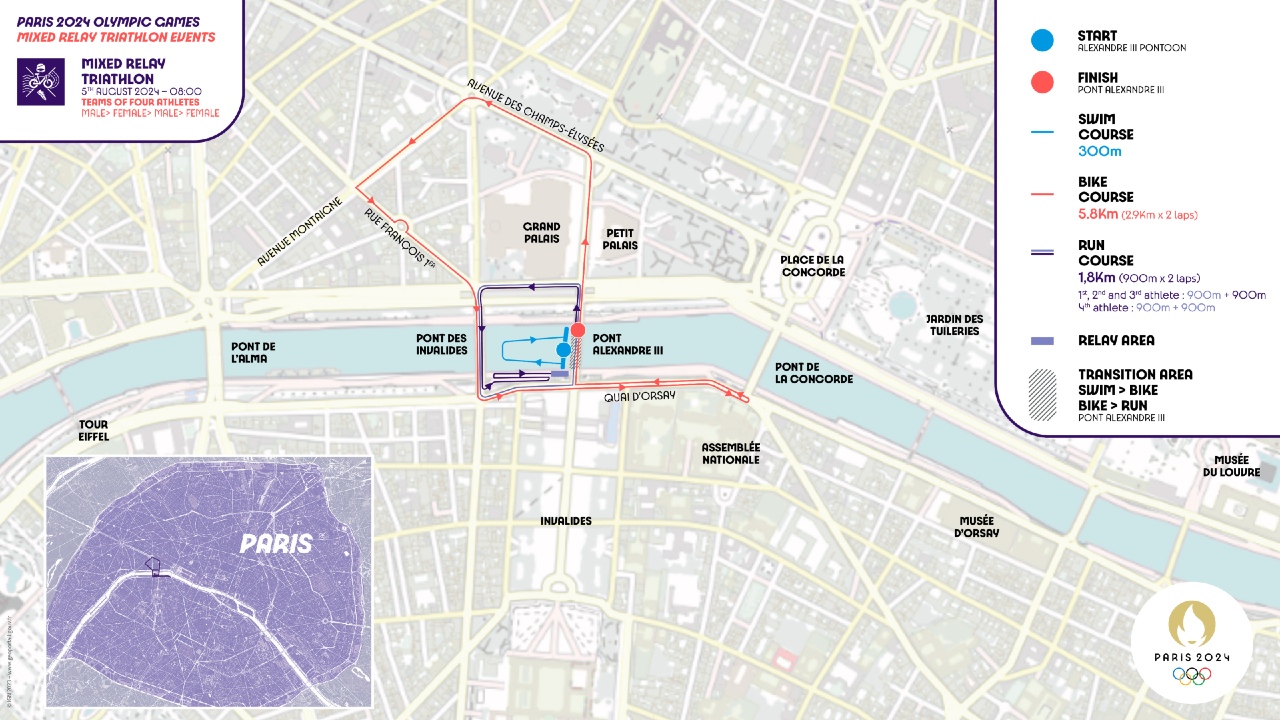Olympic Games Triathlon: In-depth Paris course guide, the key points and who it favours

So much of the focus ahead of the Paris Olympics has been on the River Seine water quality.
And no wonder – the Mixed Team Relay at the Test Event last year became a duathlon and the World Triathlon Para Cup Paris was similarly impacted.
But thankfully the weather forecast a week out looks hugely encouraging – no heavy rain is forecast, instead it’s set to be dry or sunny in the build-up, which massively reduces the risk of any issues.
So putting that threat to one side for now, what awaits the athletes in terms of the course – and what can we learn from the two individual races we did get to see at the Test Event?
Read on to find out more – and to learn where an Olympic-distance race fits in with the wider triathlon landscape, click here.
Swim leg – 1.5km
Diving off the floating Alexandre III pontoon, two laps of differing lengths await – 910m and 590m, both anti-clockwise.
The start is upstream, with the current in the athletes’ favour until the first turn and that’s a long 440m away. It’s then 30m before the second turning buoy and the turn back to the start.
For the second lap, the distances are 280m / 30m / 280m.
Both the men’s and women’s events start at 8am which will mean a relatively low sun but it’s behind the athletes at the start and might only become an issue for sighting when heading back.
They swim under the Pont des Invalides bridge on both laps where it is relatively dark so goggles choice could be tricky given the forecast sunny conditions which will lead to some sharp light contrasts.
Both arches can be used on the first lap going out (the majority used the right in both Test Event races), but then just one from then on.

The athletes exit at the end of the first lap via a ramp up to the pontoon.
And when they do so after the second lap, they have 36 steps to climb to T1 on the on the Alexandre III bridge.
What did we learn from the swim at the Test Event?
We saw two very different races, though both played out in similar conditions – non-wetsuit, with air and water temperatures in the low 20 degrees celsius.
The current was the big issue. The Seine is France’s second-longest river and under the bridges and around the buoys proved the biggest challenges, especially in the centre of the river where it was at its strongest.
Things got strung out in the women’s race which in turn impacted the bike, whereas the men’s race – possibly with the benefit of taking place a day later (it’s the other way round for the Olympics) – was less fractured.
Position on the pontoon is a tricky one – to the right looks the most direct line but further left proved better in terms of the current for for the women. Beth Potter, who won the race, chose middle and explained: “I would never ever choose the middle of the pontoon and I went for the middle today, so tried something new!”
Also note that the women were able to swim very close to the right bank on the way back at the Test Event but that option was removed for the men with the addition of a line of red buoys which couldn’t be crossed, which will be repeated at the Olympics.
Potential key points of the swim
That first 440m is a big opportunity for the stronger swimmers to set down a marker straight away, especially as it’s then against the current after the turn.
And sighting will likely be much trickier on the way back of each lap, heading into the low sun as well as the current.

And the Test Event wasn’t just for the athletes’ benefit – the organisers too have made tweaks since then.
The timing mat and the carpet on the pontoon became slippery and some of the later swimmers fell but this has now been changed with timing cables under the carpet to reduce that risk.
All in all then it does feel like the swim has the potential to be more impactful than at many WTCS events – but there’s a big caveat to that. Potter exited in 15th, 25 seconds back, in the women’s race while men’s winner Alex Yee was 18th. So staying within range is arguably the key point.
And speaking a week out from the event, Georgia Taylor-Brown feels there’s one big difference to Tokyo three years ago when she won silver – there’s no Jess Learmonth to lead out the swim, especially on the second lap.
And returning to the water quality concerns – will there be a reluctance among the athletes to make the most of the swim familiarisation? If so, that could have a huge impact because this is a course where a greater understanding of the currents and nuances could really pay dividends.
Bike leg – 40km, 7×5.715km laps
In a nutshell it’s mostly flat (just 43.5m of elevation gain / loss on each lap) on relatively wide roads.
Remember that in Olympic-distance triathlon, drafting is allowed on the bike leg so you are likely to see big packs forming.
It will show off the famous sights of Paris, including the cobbles on the Champs-Élysées which even the Tour de France peloton didn’t get to ride this year.
The cobbles are obviously an added factor – it was originally 1.53km (26.8%) of each lap but that’s now dropped very slightly given some of the patchier ones have been taken out of the equation.
That includes the U-turn on the iconic Champs-Élysées which has been made smoother and there are nine other left turns to negotiate, six of them technical and the other three sweeping ones where speed can be maintained.
Finding a line on the cobbles is more challenging compared to riding on smooth tarmac – and tyre pressure is also trickier.
For reference the neutral wheel station in Paris will have 28mm wide tyres that are inflated to 65psi front and 70psi rear.
The wind is unlikely to be a huge factor given the built-up nature of the centre of Paris. If there’s an exception to this then it could be once it widens out from Pont des Invalides into Quai d’Orsay on what is smooth tarmac.
![Kate Waugh bike Paris Test Event 2023 [Photo credit: World Triathlon / Wagner Araujo]](https://www.tri247.com/wp-content/uploads/2023/08/Kate-Waugh-bike-Paris-Test-Event-2023.jpg)
All of which brings us to the question as to how hard it is going to be to force a breakaway…
What did we learn from the bike at the Test Event?
As with the swim, they were two very different races.
The women’s one broke up far more, probably as a consequence of bigger gaps on the swim and uber biker Taylor Knibb, who races the time trial at the Olympics before the triathlon, driving the front group from the very first lap.
The men essentially formed into two groups, with the first one having a slight numerical advantage and eventual winner Alex Yee being one of the more aggressive riders in it as he tried to stretch out their advantage.
But essentially it all came back together.
And in Paris this month it’s very easy to see a similar scenario for the men, with most of the medal favourites – including the 1-2-3 from Tokyo – among the strongest bikers AND runners.
Potential key points of the bike
But it could be a different dynamic for the women. Potter and Cassandre Beaugrand are the stand-out favourites and both outstanding runners but Beaugrand in particular hasn’t always thrived on the bike, especially in testing conditions. However the forecast doesn’t suggest the cobbles will be wet on 31 July.
Things broke up in Tokyo and if reigning champion Flora Duffy and Taylor-Brown (neither of whom raced the Test Event because of injury) want to repeat those heroics then the chances are they are going to have to try to put distance between themselves and Potter / Beaugrand before the run.
As we’ve said, there’s no Jess Learmonth this time to drive things as she did in Tokyo but the joker in the pack is the already mentioned Knibb.
It’s a fascinating dynamic and will likely shape the race. And anyone caught near the back of the group is going to face the daunting challenge of trying to hold onto wheels coming out of the numerous corners – 70 in total over the course of the seven laps.
Run leg – 10km, 4×2.5km laps
For all we’ve said about the key points of the swim and bike, there’s still a strong chance – especially in the men’s race – that it will all be largely together starting the run.
And while much has been referenced in terms of the cobbles on the bike, they also have a role to play on the run.
In fact at the Test Event last year over 50% of the run (1.42km per 2.5km lap) took place on it.
But the excellent World Triathlon coaching report ahead of the Games highlighted some athlete concerns about the uneven footing given the relatively high stack on the latest carbon shoes.
Bearing that in mind – and recovery ahead of the Mixed Team Relay – that 1.42km has now been massively reduced to ‘just’ 635m per lap, or 25.4%.
What did we learn from the run at the Test Event?
There are still subtle changes in elevation but given Alex Yee ran 29 minutes flat to win the men’s race at the Test Event, was celebrating way before the line and now has less than half the cobbles to contend with, the suggestions that something like 28:30 will be required for the men doesn’t look at all unreaslistic.
![Alex Yee run Paris Test Event 2023 [Photo credit: World Triathlon / Wagner Araujo]](https://www.tri247.com/wp-content/uploads/2023/08/Alex-Yee-run-Paris-Test-Event-2023.jpg)
Indeed the top eight all went sub 29:30.
Potter went sub 33 for the women and in both events there was an incredibly high correlation between the fastest runners and the highest finishing positions.
Mixed Team Relay course details – 300m / 5.8km / 1.8km
And in terms of the Mixed Team Relay on 5 August, it’s a shorter, sharper format, again with an 8am start.
It’s a one-lap 300m swim followed by two 2.9km loops on the bike and then two lots of 900m on the run.
Unlike Tokyo it will be raced in a men / women / men / women order.



